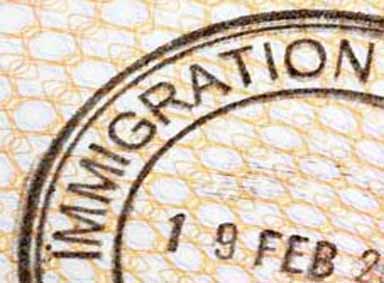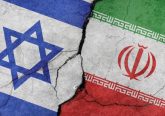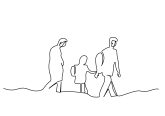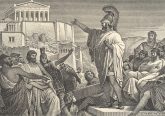 The search for a better life (sometimes couched in terms of freedom of religion) prompted migration from Europe to the new world in the seventeenth and eighteenth centuries. The ancestors of many North Americans, Australasians and white Africans or South Americans were hailed as pioneers, pilgrims and founding fathers despite the devastating consequences of their arrival on indigenous people. The settlers brought others too: Slaves from Africa or the East Indies, indentured labour from India and voluntary migrants came from the near and far East seeking greener pastures. Global mixing began centuries ago and the world has struggled with multi-culturalism and immigration since. The pursuit of ethnically pure societies is a mirage. The developed countries have multi-generational ethnic minorities from former colonies and everywhere else. Latin America and Africa are dotted with diaspora from the West and the East as well as mestizo groups. Migration continues unabated by borders and exploded on our television screens recently because of two catastrophic events: The sinking of a dingy in the Mediterranean which killed over 900 migrants and a second wave of xenophobic violence in South Africa which resulted in murder, looting and the expulsion of “foreigners” from their homes. Ironically, these events are the consequence of European state centred policy to cut back on rescue missions and anarchic but contagious violence in South Africa, where the state appears complicit by its impotence (until very recently when the army was deployed to protect foreigners).
The search for a better life (sometimes couched in terms of freedom of religion) prompted migration from Europe to the new world in the seventeenth and eighteenth centuries. The ancestors of many North Americans, Australasians and white Africans or South Americans were hailed as pioneers, pilgrims and founding fathers despite the devastating consequences of their arrival on indigenous people. The settlers brought others too: Slaves from Africa or the East Indies, indentured labour from India and voluntary migrants came from the near and far East seeking greener pastures. Global mixing began centuries ago and the world has struggled with multi-culturalism and immigration since. The pursuit of ethnically pure societies is a mirage. The developed countries have multi-generational ethnic minorities from former colonies and everywhere else. Latin America and Africa are dotted with diaspora from the West and the East as well as mestizo groups. Migration continues unabated by borders and exploded on our television screens recently because of two catastrophic events: The sinking of a dingy in the Mediterranean which killed over 900 migrants and a second wave of xenophobic violence in South Africa which resulted in murder, looting and the expulsion of “foreigners” from their homes. Ironically, these events are the consequence of European state centred policy to cut back on rescue missions and anarchic but contagious violence in South Africa, where the state appears complicit by its impotence (until very recently when the army was deployed to protect foreigners).
Poor African migrants have two choices: Head north to Europe or south to South Africa, the largest economy on the continent. Both the governments of Europe and the poor citizens of South Africa cynically believe that danger will deter immigration. People will think twice about crossing the Mediterranean if the risks of drowning or deportation are great enough. Similarly, Mozambicans and Zimbabweans will leave South Africa and others will stop coming if the probability of being killed or dispossessed is greater. “They” need to get the message that “we” don’t want them, we have too many pressures coping with our own problems. Right wing parties in Europe and King Goodwill Zwelethini in South Africa have stoked the flames of intolerance and fear, turning public opinion against migrants so fiercely that the bounds of morality and humanity are being tested. Yet Italy and Greece are overwhelmed and the migrants who have fled South Africa will return when the situation calms down and more will still come. Danger does not deter when desperation is sufficient or when the danger of staying surpasses the danger of leaving. The people who risk everything to come to Europe or South Africa are driven by more than greener pastures; they feel that their survival depends on escape. Some are asylum seekers fleeing from conflict or ethnic cleansing but others are as desperate for work and a future.
Free trade is encouraged but the free movement of people is a problem. In an article linking trade barriers to borders, economist Jochen Lorentzen argued that the European free trade zone had diminished agricultural trade with Africa, contributing to losses in the sector for African workers and farmers. The canned peaches industry in South Africa was decimated by the common market as peaches and oranges which for example, the United Kingdom used to procure from South Africa, were now purchased from southern European countries. Ironically agricultural work in Spain and Greece is being done by Moroccans and Bangladeshis among others. People go where jobs are and as jobs become concentrated in more developed countries so the pressure to “get in” intensifies. The clothing and textile industry in South Africa shrunk in response to cheaper imports from China and over 70,000 workers, mostly women, lost their jobs between 1995 and 2005. China is playing an increasingly active investment role in Africa, also obtaining large public sector construction projects which are often completed by Chinese labour and so the investment contributes little to local employment. Jobless growth and investment is a contemporary reality. With an unemployment rate of almost 30% for black South Africans, many compete with other poor Africans for low skilled work or informal trade. Anger or jealousy at informal traders from Somalia or Mozambique culminates in violent purges.
British Professor of Development Studies Guy Standing proposed the concept of the precariat as the new class of insecure workers stemming from the globalisation of the late 1990’s. The precariat encompasses the informal sector workers in developing countries but also those on zero hour contracts and other forms of insecure work in Europe or Japan. These workers lack occupational identity and a sense of the future as uncertainty becomes a way of life. Standing has being criticized for describing the precariat as dangerous class in the Marxian tradition. The precariat is not fertile ground for revolution but their desperate desire for stability and hope pivots them towards dangerous ventures. Inequality is a fact of life in capitalism so the precariat if it exists is nothing new. Yet democracy and neoliberalism have failed to deliver the structural change needed to provide freedom, jobs and full bellies for many Africans. The development project has not fulfilled its promises either. American anthropologist James Ferguson argues that it is time to acknowledge that the jobless poor in Africa will remain so for decades. Even the informal sector which for so long provided a cushion for victims of war and economic collapse has reached its limits. The instinct of the richer countries is to protect their borders at any cost as they battle against the tidal wave of those demanding inclusion. And tragic events will be repeated until there is a serious commitment to making the global economy more inclusive.








No Comment